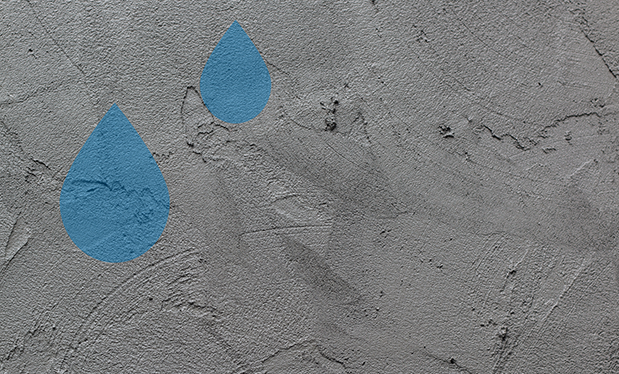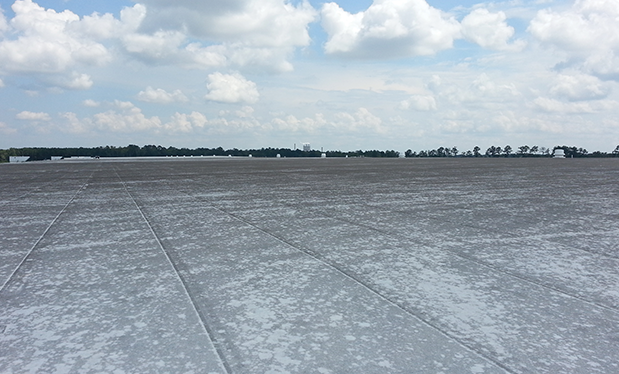When your customers contact you for help with their roofing needs, they are looking for a professional who can provide easy-to-understand information about available products and systems. Two roofing materials that often are difficult to tell apart are PVC and TPO membranes. These types of roof systems look identical, but they are not the same.
For customers interested in learning more about thermoplastic roofing materials and roof system options, the following can help guide your conversations and serve as a leave-behind piece for consumers.
What is a thermoplastic membrane?
A thermoplastic membrane is a material made with a synthetic substance that softens when heated and rehardens when cooled. Because of the way the material seals to itself, it is used as a single-ply roofing material—no other roofing layers are used during installation. These single-ply roof membranes offer flexibility and can be installed using a variety of methods, including mechanical attachment, adhered and point-affixed installation.
There are two major types of thermoplastics used in roofing: polyvinyl chloride (PVC) and thermoplastic olefin (TPO). Other types include PVC alloys and chlorinated polyethylene, but these are used much less often. Although PVC and TPO offer many of the same qualities, each has unique benefits and drawbacks.
PVC
PVC roof membranes have a long history in the roofing industry. Their use started in the early 1960s in Germany. By the 1970s, PVC use spread to the U.S. and Canada. PVC membranes now have the longest track record of any type of thermoplastic roof membrane.
According to The Vinyl Institute, PVC membranes require less energy to produce than other products such as plastic, which uses 20 percent more energy. Adding solid plasticizers to the PVC membrane allows for flexibility and weather-resistance, creating a durable product.
PVC is inherently fire-resistant. PVC sheets usually are extruded, calendared or made through spread coating and typically are reinforced with glass fiber or polyester mats. The sheets usually contain stabilizers and plasticizers for increased flexibility. A few types also have a nonwoven fleece backing.
Although black and gray are the most common colors, PVC membranes are available in a wide range of colors, allowing building owners and designers to match a variety of looks. This flexibility in design makes PVC membranes a desirable material in many commercial, as well as some residential, applications.
PVC is highly puncture-resistant in most applications and considered easy to repair. These qualities provide PVC roofs with many years of service.
TPO
TPO has been used in roof systems in the U.S. for about 25 years. It is a newer material than PVC, so research regarding the best formulations for durability is ongoing.
TPO is as heat-weldable as PVC, making its installation easy. It is available in white, black and light gray—diverse color options that allow the same potential energy savings as a white roof.
TPO is made with a polymerized rubber that makes it flexible, allowing building movement or settling, even in cold climates. Flame retardants are added to achieve fire resistance. TPO roofs can have a high level of solar reflectivity, which means the buildings stay cool even when it is hot outside.
TPO membranes also can be ENERGY STAR®-rated to meet requirements for surface reflectivity. Occupants inside a building with a TPO roof system will feel comfortable during hot weather while spending less on air-conditioning costs. This type of roofing also is 100 percent recyclable. Together, these qualities can help buildings meet U.S. Green Building Council LEED® point objectives and potentially enable a building owner to qualify for energy-saver tax credits.
According to TPORoofing.org, TPO resists mold, dirt, punctures and tears. Reinforced TPO roof membranes also can stand up to a building's thermal expansions and contractions more effectively than other single-ply roofing options, according to TPORoofing.org. Together, these add up to a highly durable roofing material, making it an even more economical choice over time.
Common installation methods
Thermoplastic roofing materials can be repeatedly softened by heat and hardened by cooling. These materials differ from thermoset materials as there is no chemical crosslinking, meaning there is no single bond linking one polymer chain to another. However, thermoplastic roofing materials can be mechanically attached. Heat-welding usually is the most common application because heat-welding allows the material to bind to itself.
PVC and TPO membranes come in a range of thicknesses from 45 mils to 80 mils. According to a study conducted by GAF, Parsippany, N.J., all TPO thicknesses can provide many years of protection, but a thicker surface can provide more resistance to tears, punctures and wear. When applying a thermoplastic membrane on a roof that will see a lot of foot traffic, thicker most likely is better.
Thermoplastic membranes most often are seamed by heat-welding through the application of hot-air welding. Because of the way thermoplastics transition from a solid to semisolid state, the overlapping panels are seamed together when they cool. The result is a continuous sheet that protects buildings more thoroughly. Heat-welding results in an impermeable surface that increases leak protection.
Installing a thermoplastic membrane is easier and less time-consuming than some other roofing options such as asphalt roofing shingles or metal. In general, PVC and TPO membranes are lightweight and typically come in 6- to 12-foot-wide rolls. This means there are fewer seams, and the material can be installed in less time. Thermoplastic membranes typically do not receive surfacings over them. In some cases, this can translate into a less expensive roofing job.
The drawbacks
As with any material, thermoplastic roof membranes also have drawbacks. Because each requires a different primer and coating during maintenance, mistakes can mean new coatings do not adhere. As a result, a patch test should be conducted before trying to apply a coating to an existing roof. Because PVC and TPO membranes are smooth and resistant to water and chemicals, they can be difficult to coat and often are used without any additional protective coatings.
Also, the plasticizers in PVC membranes can leach out, leading to brittleness over time. Because TPO membranes do not use plasticizers, they are not prone to these conditions.
TPO is a newer material. Because of this, different formulations will offer varying levels of durability. Throughout 2013-14, GAF partnered with Structural Research Inc., Middleton, Wis., to test the durability of TPO membranes. The tests concluded TPO membranes do not stand up to extreme heat as well as some other materials. If a building's roof frequently gets hotter than 275 F, it may be better to consider applying PVC instead of TPO.
All types of single-ply roof systems can deteriorate if they are on a roof exposed to high levels of foot traffic. Because there is only one layer, there is no redundancy to protect the interior if the membrane is punctured or becomes worn. Holes that develop in a roof exposed to high stress such as foot traffic may be difficult to see with the human eye; water incursions may go undetected. This is why roof system inspections are important no matter what type of material is used.
However, most potential drawbacks easily can be avoided by ensuring the material being used is appropriate for the geographical area and all roofing membranes are installed and maintained correctly.
Where to install them
PVC and TPO roofing materials are most appropriate on LEED-certified buildings and residential buildings.
Because of their ENERGY STAR ratings, PVC and TPO roof membranes are a great choice for those pursuing LEED certification. LEED buildings are built to decrease their environmental impact during construction and daily operations. In many cases, tax credits, reduced fees and other incentives are available to those who participate in the LEED program. The ENERGY STAR rating earned by some manufacturers is a bonus for those looking for environmentally friendly roofing solutions.
Although the use of single-ply roofing materials is less common in residential buildings, there still are a number of homes where they are used. Because this roofing type is most appropriate for low-slope roofs, it only will be used in residential applications with this building style. When choosing styles and colors for new roof systems, homeowners appreciate the options available when selecting PVC and TPO membrane roof systems.
Although roofs made from PVC and TPO materials are gaining popularity and acceptance in residential settings, they continue to be most commonly found in commercial applications with low-slope roofs. When a high-quality product is installed correctly, these roofs are durable and reliable.
Thermoplastic-ready
PVC and TPO membrane roof systems may look similar to consumers, but their benefits differ. For your customers interested in learning more about these thermoplastic roof systems, the preceding information can help guide your conversations with customers working through their research-gathering and decision-making processes.
Allison Reinert is senior consultant with Atlanta-based Cardinal Web Solutions, a digital marketing agency.
Want more? See "Self-adhering single plies: an emerging technology," October 2007 issue.



